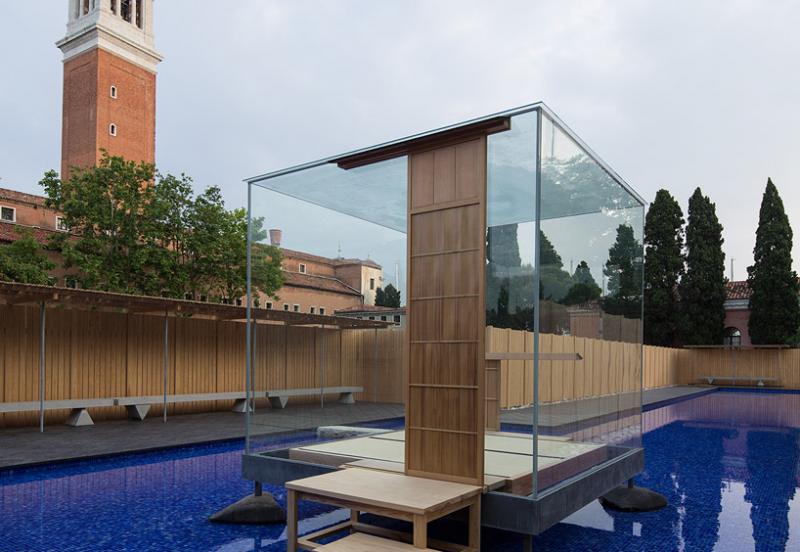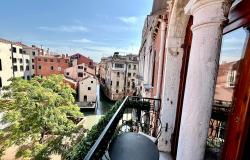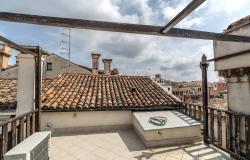Venice in summer seems to be full of the “polluting multitudes”, as Shelley put it. However, it’s possible to find peace and quiet on the little island of San Giorgio, probably because, apart from the church and monastery, there’s nothing else there, not even a shop. It was because of this tranquillity that the Japanese photographer turned installationist Hiroshi Sugimoto chose the island for his project Glass Tea House Mondrian.
From the number 2 vaporetto, you walk round the magnificent Palladian church, past rows of yachts, and turn into a garden area adjacent to the monastery. Following extraordinary walls made of broomsticks without their handles, you walk along stone paths bordered with white pebbles until you reach the inner sanctum, a rectangular pond lined with small blue tiles. Stepping stones lead to a glass cube big enough for two people, with two wooden doors, one about three feet high and the other of normal size.

Sugimoto, in his quest for abstraction, has created a tea house which for him is closely created to the pared down geometry of a Mondrian painting. His poetic fantasy was that this tea house was built by Mondrian as a “modest house where one can hear the birds sing.”
Since the 16th century, the tea ceremony in Japan has been raised to the level of art, encompassing meticulous ritual, careful choice of colour and shape, and graceful movement. The two doors are significant. The woman serving the tea enters through the large door, but her guest must bend down, almost in homage, and if he is a warrior, the small entry necessitates the removal of his sword.
This glass tea house has been constructed so that the ceremony can be performed whilst 30 people observe it from the edges of the pool. Unfortunately, nobody realised that a glass cube in full sun would be insupportable in the heat of a Venetian summer. The performances have been suspended until September, and booking is essential as the few which took place in June proved immensely popular.

Chatting to the custodian about the piece, I learned that it is hoped it will remain on San Giorgio in its perfect setting of monastic calm rather than be sold and erected elsewhere. I mentioned that I’d seen an exhibition of photographs by Sugimoto a couple of years ago at the Fortuny Museum. To my surprise, she mentioned another current exhibition in Venice which I hadn’t seen publicised at all, but decided I had to find it. All she knew was that it was near San Barnaba.
There were no signs in the campo, so I decided to ask. It took some detective work! The church of San Barnaba hosts a permanent exhibition of wooden machines created from the drawings of Leonardo. I asked at the entrance, but the reply was, “No idea. Never heard of him.”
Next, I tried the lovely small Hotel San Barnaba down the narrow calle leading to the vaporetto stop. Here they were more helpful. The man at the reception desk tapped the name Sugimoto and Venice into his computer and found that the exhibition was a short walk along the canal in Palazzetto Tito. A very modest poster told us we’d reached the right place.

It’s always a treat to be able to go into some wonderful old Venetian building not normally on view, especially when the 94 year-old owner lives on the top floor. The Modern Times exhibition was on the piano nobile, chosen by Sugimoto himself as the perfect setting for his work because of the light filtered through the hundreds of glass circles in the ancient windows. The photographs are large, out-of-focus images of architectural masterpieces in black and white. Again, the setting is calm and supremely simple. We were the only visitors, yet outside, the Disneyland that is Venice at the height of the tourist season was in full swing.
The effect of Sugimoto’s work in Venice is to transmit a deep sense of tranquillity at odds with the scurrying masses all around. I very much hope that the cultural officials will find a way to keep the glass tea house in its perfect setting, and that there will always be a little corner of Venice that is forever Japan.
The 'Glass Tea House Mondrian' installation is on view until November 29, 2014. For more information and to make a reservation, click here.
For opening times of Sugimoto's "Modern Times" photographic exhibition at Palazzetto Tito, click here. [Exhibit closes October 12.]










